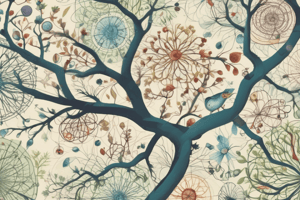Podcast
Questions and Answers
What is the study of interactions between organisms and their environment?
What is the study of interactions between organisms and their environment?
- Zoology
- Microbiology
- Ecology (correct)
- Botany
What is the control center of a cell?
What is the control center of a cell?
- Endoplasmic reticulum
- Mitochondria
- Nucleus (correct)
- Cytoplasm
What is the molecule containing genetic information?
What is the molecule containing genetic information?
- Protein
- DNA (correct)
- Lipid
- Carbohydrate
What is the process of gamete formation?
What is the process of gamete formation?
What is the study of evolutionary relationships between organisms?
What is the study of evolutionary relationships between organisms?
What is the sequence of predator-prey relationships in an ecosystem?
What is the sequence of predator-prey relationships in an ecosystem?
What is the term for the variety of species in an ecosystem?
What is the term for the variety of species in an ecosystem?
What is the function of mitochondria in a cell?
What is the function of mitochondria in a cell?
Flashcards are hidden until you start studying
Study Notes
Branches of Biology
- Botany: study of plants
- Zoology: study of animals
- Microbiology: study of microorganisms
- Ecology: study of interactions between organisms and their environment
Cell Biology
- Cell: basic unit of life
- Cell membrane: semi-permeable membrane surrounding the cell
- Cell wall: rigid outer layer in plant cells
- Cytoplasm: jelly-like substance inside the cell membrane
- Nucleus: control center of the cell
- Mitochondria: site of cellular respiration
- Endoplasmic reticulum: network of tubules and sacs for protein synthesis and transport
Genetics
- DNA (deoxyribonucleic acid): molecule containing genetic information
- Genes: units of heredity
- Chromosomes: thread-like structures made of DNA and proteins
- Meiosis: process of gamete formation
- Mendel's laws: principles of inheritance
- Law of segregation: each trait is determined by two alleles
- Law of independent assortment: alleles of different genes are sorted independently
Evolution
- Theory of evolution: process of change in species over time
- Natural selection: mechanism driving evolution
- Speciation: formation of new species
- Fossil record: evidence of evolutionary history
- Phylogeny: study of evolutionary relationships between organisms
Ecosystems
- Ecosystem: community of organisms and their environment
- Biodiversity: variety of species in an ecosystem
- Food chain: sequence of predator-prey relationships
- Energy pyramid: representation of energy flow in an ecosystem
- Biome: large region with unique climate and ecosystem characteristics
Biological Molecules
- Carbohydrates: energy storage molecules (e.g. glucose)
- Proteins: structural and functional molecules (e.g. enzymes)
- Lipids: energy storage and structural molecules (e.g. fatty acids)
- Nucleic acids: genetic material (e.g. DNA, RNA)
Branches of Biology
- Botany is the scientific study of plants, including their structure, growth, evolution, classification, and distribution.
- Zoology is the scientific study of animals, including their structure, behavior, evolution, classification, and distribution.
Cell Biology
- A cell is the basic unit of life, consisting of a cell membrane, cytoplasm, and genetic material.
- The cell membrane is semi-permeable, regulating what enters and leaves the cell.
- Plant cells have a rigid outer layer called the cell wall, providing structural support.
- Cytoplasm is the jelly-like substance inside the cell membrane, containing various organelles.
- The nucleus is the control center of the cell, containing most of the cell's genetic material.
- Mitochondria are the site of cellular respiration, generating energy for the cell.
- The endoplasmic reticulum is a network of tubules and sacs involved in protein synthesis and transport.
Genetics
- DNA (deoxyribonucleic acid) is a molecule containing the genetic information necessary for life.
- Genes are the units of heredity, transmitting information from one generation to the next.
- Chromosomes are thread-like structures made of DNA and proteins, carrying genetic information.
- Meiosis is the process of gamete formation, resulting in four non-identical daughter cells.
- Mendel's laws describe the principles of inheritance, including the Law of Segregation and the Law of Independent Assortment.
- The Law of Segregation states that each trait is determined by two alleles, one inherited from each parent.
- The Law of Independent Assortment states that alleles of different genes are sorted independently during gamete formation.
Evolution
- The Theory of Evolution describes the process of change in species over time, resulting in diversity and adaptation.
- Natural selection is the mechanism driving evolution, favoring individuals with advantageous traits.
- Speciation is the formation of new species, often resulting from geographic isolation or genetic drift.
- The fossil record provides evidence of evolutionary history, with transitional forms and Cambrian explosion.
- Phylogeny is the study of evolutionary relationships between organisms, reconstructing their common ancestry.
Ecosystems
- An ecosystem is a community of organisms and their environment, interacting with each other and their surroundings.
- Biodiversity refers to the variety of species in an ecosystem, including species richness and evenness.
- A food chain is a sequence of predator-prey relationships, with energy flowing from one level to the next.
- The energy pyramid represents the flow of energy in an ecosystem, with producers at the base and top predators at the apex.
- A biome is a large region with unique climate and ecosystem characteristics, such as tropical rainforests or coral reefs.
Biological Molecules
- Carbohydrates are energy storage molecules, including glucose and starch.
- Proteins perform structural and functional roles, such as enzymes, receptors, and transport molecules.
- Lipids are energy storage and structural molecules, including fatty acids, triglycerides, and phospholipids.
- Nucleic acids, including DNA and RNA, contain the genetic material necessary for life.
Studying That Suits You
Use AI to generate personalized quizzes and flashcards to suit your learning preferences.




